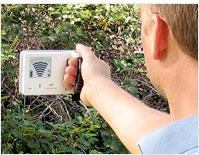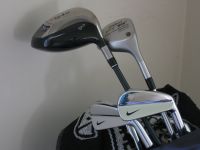My idea was to irradiate golf balls with a low-level radioactive isotope. Golfers who lost such balls could simply use a Geiger counter to find their balls. It sounded great at first, but then I realized that there could be litigation risks associated with potential health hazards to golfers who carried radioactive balls in their pocket. Would it really be so bad to grow another arm? Who knows, it could improve your swing.
 Anyway, a company has already developed a similar concept, without the radiation risks. RadarGolf has developed a microchip that is designed to be embedded into a golf ball. The chip is designed to communicate with a handheld device carried by the golfer. When the golfer loses his ball, he simply activates the handheld to transmit a specific radio frequency signal. Like a Spidey tracer, the chip receives the signal and sends back its own signal, causing the handheld to beep faster and at a higher pitch as it gets closer to the ball.
Anyway, a company has already developed a similar concept, without the radiation risks. RadarGolf has developed a microchip that is designed to be embedded into a golf ball. The chip is designed to communicate with a handheld device carried by the golfer. When the golfer loses his ball, he simply activates the handheld to transmit a specific radio frequency signal. Like a Spidey tracer, the chip receives the signal and sends back its own signal, causing the handheld to beep faster and at a higher pitch as it gets closer to the ball.I think that this product has some potential for success. However, one glaring shortcoming that I see is the fact that the system only works specifically with RadarGolf Balls. There's just no way that you're going to pry golfers away from their precious Pro V1s to play some findable ball that most wouldn't want to find in the first place. Therefore, I recommend that RadarGolf pursue a strategy to get their product in established golf ball brands. I'm sure that Titleist would be interested to incorporate the RadarGolf chip into their golf balls as a premium feature or product extension. For example, they could retail a dozen regular Pro V1s at $50 and RadarGolf Pro V1s at $60. I think that such a product offering could be attractive to certain golfers. This all sounds great in theory, but we'll have to see how it works in practice.
The RadarGolf System (the handheld unit with a dozen balls) was scheduled to be introduced sometime this month on the Web for $349.95. However, the last time I checked, there was no purchasing info. Maybe they're rethinking their business model. I think that would be a good idea.
Labels: Equipment




